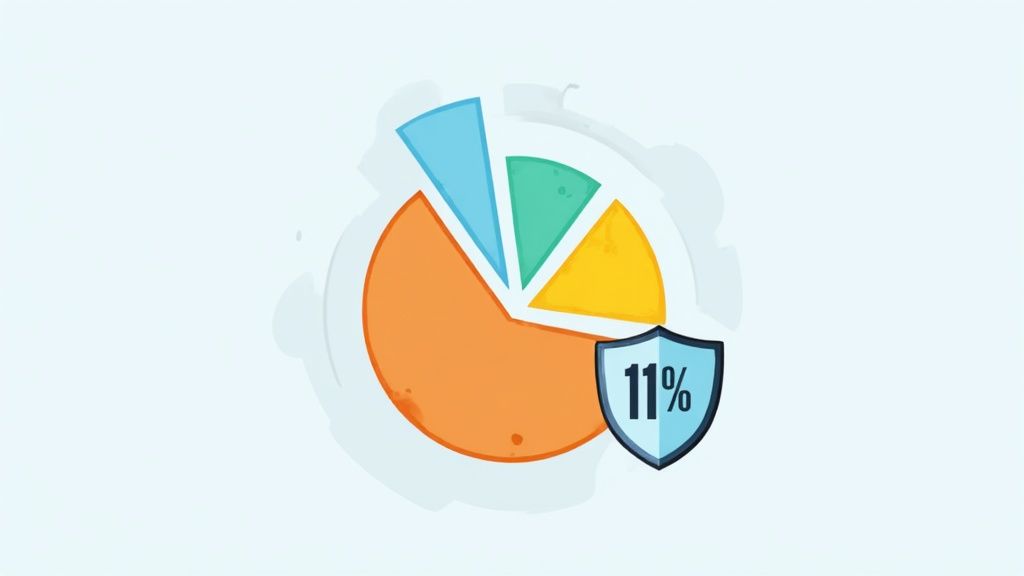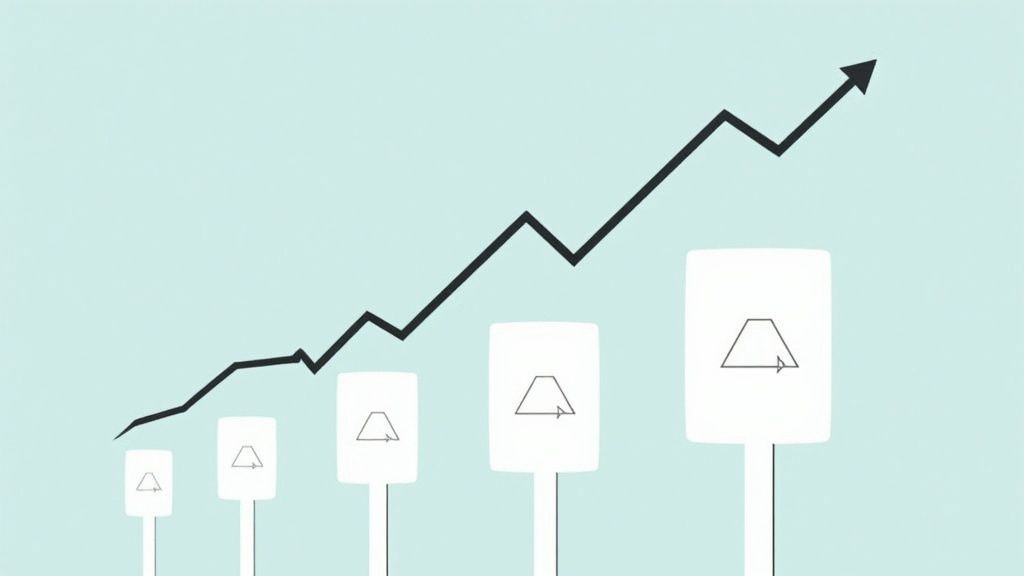Ever wondered how top traders seem to stay calm and consistently make smart moves? It’s not magic – it’s a system. They rely on a set of core rules they practice every single day, turning the crazy market into something they can manage. This isn't about complex math or needing a supercomputer. It’s about building smart habits, just like a pro athlete trains for a big game.
Forget the confusing jargon you see in movies. We're going to break down seven super practical, daily trading tips that anyone can understand and start using right away. Think of this as your personal trading playbook. We'll explore powerful ideas from legends like Paul Tudor Jones, who famously said, “The most important rule of trading is to play great defense, not great offense.” We'll even see how modern celebrities like Ashton Kutcher apply similar principles of smart risk-taking in their tech investments, focusing on solid strategies over wild gambles.
By the end of this guide, you’ll have a clear, actionable plan to approach the market with more confidence and control. You'll learn how to build a pre-market routine, manage risk like a pro, and review your moves to get better every single day. Let's dive in.
1. Start with a Solid Pre-Market Routine
Ever see pro athletes go through a strict pre-game ritual? It’s not just for show; it's about getting in the zone, focusing their energy, and preparing to win. As a trader, your "game" is the market, and your pre-market routine is your essential warm-up. It's the dedicated time you set aside before the opening bell to go from being a spectator to a prepared player.
This process means checking the news, looking at the economic calendar, and spotting potential trades before the market's chaos begins. By doing this, you create a game plan. This lets you trade with confidence instead of chasing every random price jump. Many successful traders, like Mike Bellafiore of SMB Capital, emphasize that your prep work directly predicts how well you'll perform.
How to Build Your Pre-Market Checklist
A good pre-market routine is like a pilot's pre-flight checklist – structured and repeatable. Here’s a simple framework you can use:
- Global Market Check (30 mins): What happened while you were asleep? Look at major Asian and European markets (like the Nikkei or DAX). This gives you a feel for the overall market vibe. Did a major economic report from another country shake things up?
- Economic Calendar Review (15 mins): Check for big economic news scheduled for the day, like inflation data (CPI) or job reports. These events can cause huge price swings, and you need to know when they’re happening.
- Build Your Watchlist (30-45 mins): Use a pre-market scanner (you can find these on platforms like TradingView) to find stocks that are already busy with high trading volume. These are the "stocks in play." Instead of watching 50 stocks, narrow your focus to the top 3-5 that fit your strategy.
- Chart Your Key Levels (15 mins): For each stock on your shortlist, find the key price levels where it previously bounced up (support) or got rejected (resistance). Mark these on your charts. This is your battle map for the day.
By following a consistent routine, you replace emotional guessing with a smart, strategic approach. This is one of the most crucial daily trading tips for long-term success. You're not just hoping for a good day; you're preparing for one.
2. Use the 1% Risk Management Rule
Imagine playing a video game where one mistake makes you lose everything. Super frustrating, right? Trading can feel that way without a good defense. The 1% rule is your ultimate shield. It's a simple rule: never risk more than 1% of your total account on a single trade. This isn't about limiting your profits; it's about making sure you stay in the game long enough to win.
This simple rule is loved by legendary trading coaches because it mathematically prevents a few bad trades from wiping you out. A losing streak of five trades only results in a 5% account loss, which is totally manageable. Without this rule, the same streak could be a disaster. It forces you to focus on protecting your money, which is the real secret to lasting in trading. Fun fact: Even billionaire investor George Soros, known for his massive bets, was obsessed with risk management. He famously said, "It's not whether you're right or wrong that's important, but how much money you make when you're right and how much you lose when you're wrong."
How to Apply the 1% Rule
Applying this rule is a simple, two-step calculation you must do before entering any trade. To use this rule and manage any financial strategy, you need a good grasp of basic math concepts like understanding percentages. Here’s how it works:
- Calculate Your Max Dollar Risk: First, figure out what 1% of your trading account is. If you have a $10,000 account, your maximum risk per trade is $100 ($10,000 x 0.01). This is the absolute most you can lose if the trade goes south.
- Determine Your Stop-Loss: Before you trade, you must know your exit point if you're wrong. Let's say you want to buy a stock at $25 and your analysis says to put a stop-loss at $24.50. Your risk per share is $0.50.
- Calculate Your Position Size: Now, divide your max dollar risk by your per-share risk. In our example: $100 (max risk) / $0.50 (risk per share) = 200 shares. That's the maximum number of shares you can buy for this trade.
- Adjust for Every Trade: Your position size will change depending on the trade's stop-loss, but your max dollar risk (1% of your current account) stays the same. This disciplined approach is one of the most powerful daily trading tips for consistency.
By making this rule non-negotiable, you take emotion and fear out of your decisions. You're no longer gambling; you're managing risk like a pro.
3. Trade Only During High-Liquidity Sessions
Imagine trying to surf on a calm lake versus the ocean. The ocean has powerful waves and momentum, while the lake is flat and boring. The stock market is similar. Trading during high-liquidity sessions is like surfing in the ocean; there are more buyers and sellers (more "waves"), which means faster trades, better prices, and more reliable price movements.
This means you should focus your energy when the market is most active, usually the first and last hours of the trading day. Most of the day's action happens in these windows. By avoiding the slow, boring midday period, you can focus on the best opportunities and avoid the frustration of a market that's going nowhere. Pro traders often make most of their money during these key hours and use the midday lull for analysis, not for trading.
How to Focus on High-Liquidity Windows
Timing is everything. Knowing when to trade is as important as knowing what to trade. Here’s how to sync up with the market's most energetic periods:
- The Golden Hours: For U.S. stock traders, the best times are usually 9:30 AM – 11:00 AM EST and 3:00 PM – 4:00 PM EST. Most pro day traders are done by 11:00 AM.
- Avoid the Opening Chaos: The first 5-15 minutes after the market opens can be pure chaos. It’s often driven by overnight news and hype. Let the market settle and show its real direction before you jump in.
- The Midday Dead Zone: From about 11:30 AM to 2:30 PM EST, trading volume often dries up. Big institutional traders are at lunch, and the market tends to drift sideways. This is a high-risk, low-reward time-perfect for practice, but not for your real money.
- Watch for Overlaps in Forex: If you trade currencies, the best time is when major market sessions overlap. For the Euro vs. the US Dollar (EUR/USD), the sweet spot is when the London and New York markets are both open (8:00 AM – 12:00 PM EST). You can learn more about how to track these forex market hours on financeillustrated.com.
By using this timing strategy, you put the odds in your favor. This is one of the most effective daily trading tips because it forces you to trade when the market offers the clearest opportunities, helping you save your money and mental energy for when it counts.
4. Follow the Trend with Moving Average Confirmation
Ever heard the saying, "the trend is your friend"? It's one of the oldest trading rules for a reason. Instead of fighting the market's momentum, smart traders learn to ride its waves. Following the trend means you trade in the same direction the market is already going, and moving averages are the best tool to see which way that current is flowing.
A moving average (MA) is a line on your chart that smooths out all the noisy price wiggles, making it easier to see the real trend. When the price is consistently above the moving average, it signals an uptrend; when it's below, it suggests a downtrend. Legendary traders like Paul Tudor Jones built their careers on this idea, knowing it's way more profitable to go with the flow than to swim against the tide.
How to Use Moving Averages for Trend Confirmation
Using moving averages is like having a GPS for the market. They give you clear, visual signals to guide your trades. Here’s a simple way to get started:
- Identify the Main Trend: Use longer-term MAs like the 50-period and 200-period on a daily chart. When the 50 MA crosses above the 200 MA (a "Golden Cross"), it signals a strong bullish trend. A cross below (a "Death Cross") signals a bearish trend.
- Find Your Entry Points: On a shorter timeframe (like a 5-minute chart), use faster MAs like the 9-period and 20-period Exponential Moving Averages (EMAs). In a strong uptrend, a common strategy is to buy when the price pulls back and touches the 20 EMA, which acts like a moving support line.
- Combine with Other Clues: For a stronger signal, combine MAs with volume. If a stock bounces off its 20 EMA with a huge spike in buying volume, it’s a much more reliable signal than a bounce with low volume.
- Know When to Stay Out: If the price is just chopping back and forth across the moving average, it means the market has no clear trend. This is a sign to be patient and wait for a clearer direction.
By using moving averages, you stop guessing and start making informed decisions based on the market's actual momentum. This is one of the most powerful daily trading tips for building a consistent and disciplined approach.
5. Set Multiple Profit Targets and Scale Out
Ever closed a winning trade just to watch it double in price without you? It’s a terrible feeling. On the other hand, holding on for a huge gain only to see it reverse and turn into a loss is even worse. This is where a pro technique called "scaling out" comes in. It’s a strategy that lets you lock in profits while still giving you a shot at a bigger move.
Instead of an all-or-nothing approach where you sell everything at one price, scaling out means selling parts of your position at different, pre-planned price levels. This powerful method, used by legendary traders like Linda Raschke, helps reduce stress and removes the emotional guesswork. It turns taking profits from one big, scary decision into a calm, multi-step process.
How to Scale Out of Your Trades
The key is to have your exit plan figured out before you even enter the trade. This pre-planning is one of the most vital daily trading tips for staying disciplined. Here’s a practical way to do it:
- Define Your Targets Before Entry: Let's say you buy 300 shares of a stock. Before you click "buy," decide on your exit points. For example, your plan could be to sell 150 shares at your first target (e.g., +$0.50), another 100 at your second target (e.g., +$1.00), and let the final 50 shares run.
- Move Your Stop-Loss to Breakeven: This is a game-changer. Once your first profit target is hit, move your stop-loss for the remaining shares up to your original entry price. This makes the rest of the trade "risk-free," since you can't lose money on it anymore. This one move can dramatically improve your trading psychology.
- Use Charts to Set Realistic Levels: Don't just pick profit targets out of thin air. Use your chart to find logical resistance levels or other technical points where the price might struggle. The Average True Range (ATR) indicator is also a great tool for setting realistic targets based on the stock's typical daily movement.
- Adjust Based on the Market: Be flexible. In a choppy, uncertain market, you might want to scale out faster, taking more profit at your first target. In a strong, trending market, you might let a bigger piece of your position run for a larger gain.
By scaling out, you pay yourself along the way. It’s a disciplined approach that balances greed and fear, allowing you to lock in gains while still having a chance at those massive home-run trades.
6. Wait for Confirmation Before Entry
Ever jumped into a trade thinking it was a "sure thing," only to see the price immediately go against you? This happens when you act on what you think will happen instead of what is actually happening. Waiting for the market to confirm your idea is like waiting for the green light before crossing the street; it’s a simple rule that makes you much safer and more successful.
This means you let the price action prove you're right before you put your money on the line. For instance, instead of buying a stock the second it touches a support level, you wait for a clear signal that other buyers are actually showing up. Legendary traders like Peter Brandt, who is a master of chart patterns, built their careers on this discipline. They know that a potential setup isn't the same as a valid one.
How to Practice Patient Confirmation
Confirmation turns your trading from a guessing game into a methodical process. Here’s a checklist to help you wait for the right signals:
- Define Your Signal Clearly: What does confirmation look like for your strategy? Write it down. Is it a 5-minute candle closing clearly above a resistance line? Is it a breakout with a big spike in volume? Be specific.
- Use Price Action Patterns: Look for validating candlestick patterns on your chart. For a long entry at support, you might wait for a bullish engulfing candle (a big green candle that "eats" the previous red one) to form. This shows that buyers have taken control.
- Combine Your Signals: Don't rely on just one thing. A stronger setup might be a price breaking above a key moving average and being confirmed by a surge in buying volume. Two signals are better than one.
- Set Price Alerts: Instead of staring at the chart and getting tempted to jump in too early, set an alert at your confirmation level. This frees up your mental energy and forces you to wait for the market to come to you.
Adopting this practice is one of the most powerful daily trading tips for filtering out weak trades and avoiding emotional, impulsive decisions. You might miss the very beginning of a move, but you will catch more of the reliable, high-quality trades that actually make you money.
7. Review and Journal Every Trade
Imagine a pro athlete watching game tapes to find their mistakes and strengths. That's exactly what a trading journal does for you. It's your personal "game tape," helping you learn from your experiences. Journaling is what separates a novice trader who gets lucky or unlucky from a professional who understands their own performance.
This process involves writing down every single trade-not just the wins, but especially the losses. You record why you took the trade, your entry and exit points, and even how you were feeling. A famous trading psychologist, Brett Steenbarger, often says that self-awareness is a trader's greatest asset. A journal is the best tool for building that awareness, turning your trading data into a roadmap for improvement. Even someone like Oprah Winfrey, a master of self-reflection, has championed journaling for years as a way to understand one's own patterns and achieve goals.
How to Build Your Trading Journal
A great journal is more than just a list of wins and losses; it’s a story of your decision-making. Here’s a simple framework to get started:
- Capture the Essentials: For every trade, log the date, stock ticker, entry price, exit price, stop-loss, and final profit or loss. This is your basic data.
- Explain Your "Why": Why did you take this trade? Was it a chart pattern? A news story? Write down your reasoning. Also, take a screenshot of the chart when you entered and exited, and draw your notes on it. This visual context is priceless.
- Track Your Mindset: Rate your emotional state on a scale of 1-5. Were you feeling confident, fearful, or greedy? You might discover that your worst trades happen when you're feeling emotional.
- Review and Find Patterns: Every weekend, review your week's trades. Look for patterns. Do you always lose money on Fridays? Do your best trades come from a specific setup? This is where your data turns into powerful insights. To take it a step further, you can learn how to backtest your trading strategies to see if your patterns hold up over time.
By keeping a journal, you create a feedback loop that helps you learn faster. This is one of the most powerful daily trading tips because it forces you to be your own coach, helping you find your strengths and eliminate costly mistakes.
7 Key Daily Trading Tips Comparison
| Strategy | 🔄 Implementation Complexity | ⚡ Resource Requirements | 📊 Expected Outcomes | 💡 Ideal Use Cases | ⭐ Key Advantages |
|---|---|---|---|---|---|
| Start with a Solid Pre-Market Routine | Medium (30-90 min daily early start) | Requires access to news, futures, alerts | Better prepared trades, reduced impulsivity | Day traders preparing for market open | Reduces emotions, identifies setups early |
| Use the 1% Risk Management Rule | Low-Medium (requires precise calculations) | Basic math tools, position size calculator | Capital preservation, steady account growth | All traders prioritizing risk control | Protects capital, promotes discipline |
| Trade Only During High-Liquidity Sessions | Low (time-restricted trading hours) | Requires trading during key sessions | Tighter spreads, better execution, clearer trends | Day traders focusing on volatile market periods | Lower costs, higher quality setups |
| Follow the Trend with Moving Average Confirmation | Medium (requires indicator setup) | Charting software with MA indicators | Higher win rates, clearer trend direction | Trend followers and technical analysts | Clear entry signals, removes guesswork |
| Set Multiple Profit Targets and Scale Out | Medium-High (complex position management) | Advanced order management capability | Reduced regret, improved risk-reward | Traders managing profits on longer intraday/swing trades | Locks partial profits, eases exit-related anxiety |
| Wait for Confirmation Before Entry | Medium (requires patience and rules) | Alert systems, charting tools | Higher win rate, fewer false signals | Traders seeking improved trade quality | Reduces false breakouts, builds discipline |
| Review and Journal Every Trade | Medium-High (ongoing daily commitment) | Journal software or spreadsheets | Improved performance via self-analysis | All traders committed to continuous improvement | Identifies patterns, enforces accountability |
Your Daily Checklist for Smarter Trading
You've just learned seven powerful daily trading tips that form a blueprint for a disciplined and successful trading routine. Think of this as your new daily checklist. From the Pre-Market Routine that sets you up for success to the non-negotiable 1% Risk Management Rule that protects your money, you now have the tools to trade with a plan, not just a feeling.
The journey to becoming a consistent trader is a marathon, not a sprint. Legendary investor Warren Buffett once said, "The stock market is a device for transferring money from the impatient to the patient." This wisdom is at the heart of the tips we've discussed. Waiting for confirmation, trading only during the busy hours, and scaling out of positions are all acts of patience. They are the small, smart actions that separate pro traders from amateurs.
Making These Habits Stick
Knowing these tips is one thing, but making them habits is what really matters. Your trade journal is your personal coach, helping you learn from every win and loss. Your pre-market analysis is your strategic map for the day ahead.
Staying this disciplined day after day takes mental stamina. A trader's performance is tied directly to their mindset. It's crucial to create an environment that helps you focus. For practical strategies on this, you can explore ways to stay focused and boost productivity during your most critical trading hours. Mastering your focus is just as important as mastering your strategy.
Your Path Forward: From Knowledge to Action
The difference between reading about trading and becoming a trader is practice. The tips in this article are your building blocks. But you have to be the one to put them together. By committing to this checklist, you build a professional framework for your trading decisions. This structure will guide you through market ups and downs and help you make calculated moves instead of impulsive guesses. Start tomorrow. Choose one tip to master this week, then add another next week. Before you know it, these practices will become second nature, paving your way toward smarter, more confident trading.
Ready to turn these daily trading tips into real skills without risking a single dollar? Visit financeillustrated.com to access our interactive trading simulator, educational games, and in-depth courses. It's the perfect environment to practice everything you've learned here and build the habits of a pro trader in a fun, risk-free setting.



